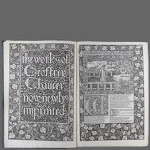
My second museum experience took place on Saturday, November 15th at the New Britain Art Museum of American Art (NBMAA), New Britain, Connecticut. Looking at this museum from the outside was deceiving. But as soon as we walked though the doors, there was a feeling of knowing that a great and exciting experience was awaiting us.
As we walk up to the admissions desk, we were greeted by a cordial desk clerk, who gave us our admissions ticket, which turned out to be a sticker that said "where art meets life.” This was a great idea to ponder as we started our tour. If an individual wants a guided tour with a docent, you need schedule it ahead of time. However, the museum offers visitors a guided audio tour. You are given a hand held device that gives detailed information on the works of art the museum has to offer. This was very useful and I encourage anyone touring this museum to take this along with them.
Here is a little bit of history about The NBMAA. It was founded in 1903, and is known as a renowned art museum.[1] In fact, it is the oldest museum in the country to collect only American Art; it was designed and designated to be the first museum to have just American art, and is the only one in the country.[2] Due to great persistence, a man by the name of John Butler Talcott, who was also an industrialist produced resources to obtain modern oil paintings, with assistance from New York museums and galleries. [3] New Britain Museum of American Art know holds over 5,000 pieces of American Art from over three centuries.[4]
In 2006, the NBMAA added on an addition called the Chase Family Building, which was created by landscape architect Frederick Law Olmsted.[5] This 43,000 square-foot Chase Family Building was designed by award-winning Ann Beha Architect of Boston.[6] Also, there are gardens and outdoor sculptures that surround the building. There is a café that overlooks Walnut Hill Park.
On to the tour, the first piece of art work that came into sight was hanging from the ceiling was art work called a Dale Chihuly chandelier. This piece is called “Blue and Beyond Blue.” It is internationally renowned. Chihuly’s works are housed in over 200 museums worldwide.[7] This piece is mounted in the LeWitt Landing.
Next point of interest, only a few steps from the Chihuly’s chandelier, directly facing us on the wall, was made of every color imaginable. This work of art was called “The Gravity of Color”, by famous artist Lisa Hoke. While looking at this masterpiece from far away, it seemed as if it was made of pieces of plastic that were stuck together. As we got closer, we realized it was made of plastic cups of all different colors, flowing in a beautiful pattern. My first thought was how many cups she had to use to create this work of art. How fabulous! If you venture to NBMAA you can’t miss this: it covers one full wall and a half, from floor to ceiling.
The next artist that captured our attention was Thomas Hart Benton’s five murals that wallpapered the walls of an enormous room. The mural that intrigued me the most was the “Arts of the City.” This mural told the story of the Great Depression, 1932. This amazing picture took place when the stock market crashed in 1929, after Roosevelt won the presidential election, as well as when prohibition, and bootlegging of alcohol took hold of towns and cities. The titles of the other murals in the room were “Arts of the West,” which captured memories of when Benton was a small boy, born and raised in Neosho, Missouri. [8] He lived his adult life in Washington D.C., Chicago, Paris, and New York.[9] The next mural depicted Indian Art. This portrayed the way Benton had seen the Plain Indians, and their ways of life. [10] Last but not least, was a mural that told a story of how Benton came from political family. His father was elected to congress in 1896 and the family kept residence between Missouri and Washington D.C.[11] Memories from his political life style stayed with him throughout his life, which he made fun of in this mural. [12]
Upon completion of the tour, do not forget to grab a bit to eat at the Café and visit the gift shop. The food is good and the gifts are many. Remember to pick up the museum calendar; there are many great up coming events to attend.
[1] www.nbmaa.com
[2] Ibid.
[3] Ibid.
[4] Ibid.
[5] Ibid.
[6] Ibid.
[7] Ibid.
[8] Ibid.
[9] Ibid.
[10] Ibid.
[11] Ibid.
[12] Ibid.






2 comments:
Linda, this brings back memories of my visit a few weeks ago. Great job!!
Thank-you, KJ. I'm glad you enjoyed your visit!
Post a Comment